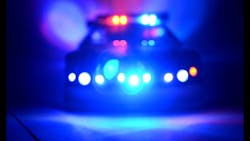Years ago, if you were to ask a child to draw a police car, you would undoubtedly get a picture of a black and white vehicle—probably a Crown Vic style—with red and blue flashing lights. Today, however, police vehicles are as varied as the departments themselves. There is also a small but significant move by some agencies to forego the red/blue light variation for blue lights only.
Earlier this year, the Draper Police Department announced it would become the first department in the state of Utah to switch to all blue lights. The department cited several reasons for this change, including aesthetics, department branding and safety. “We believe anything that enhances officer safety is of value,” Draper Police Chief John Eining said in an announcement. The key word in this change is safety. In 2019, 14 law enforcement officers were struck by a vehicle and killed in the line of duty. But will changing to all blue lights increase the safety of LEOs? The answer isn’t simple.
What the research says
Warning light color, intensity and flash rate varies from department to department throughout the U.S.
While most studies on the subject have found that blue lamps are more conspicuous in nighttime conditions than other colors, including red, there’s debate around daytime color.
In 2008, the NIJ funded a study to examine how the color and intensity of warning lights affect driver vision and emergency vehicle safety, finding that blue was the easiest color for participants to see both day and night. Similarly, the University of Michigan’s Transportation Research Institute found in its 2008 study that blue was actually more effective in daylight conditions than white, yellow and red.
A 2019 Justice Technology Information Center study, however, determined that red lights are more visible in the daytime and blue lights are more visible at night and recommends agencies use a combination of colors. Similarly, a 2004 study from the IACP’s Law Enforcement Stops and Safety Subcommittee reportedly found that, "In darkness, blue is more effective. During daylight, red is more effective. Blue has the advantage at night of standing out better among a variety of red-light sources, notably vehicle brake lights. However, during nighttime conditions of smoke, fog, or haze, blue loses its advantage and red is better.”
Does consistency matter?
Draper is not the first department in the country to make this move to blue lights for safety reasons. The Ohio Highway Patrol moved to all blue light bars in 2012 (followed by several other Ohio police departments) and Virginia State Police have traditionally been using blue lights (though some VSP vehicles are now using a mix of red and blue).
While LEDs have helped emergency lighting become much more visible and brighter, there is no national standard system of warning light signals. There is a lack of consistency in emergency lighting not only from state to state, but jurisdiction to jurisdiction. More important than consistency, however, is officer safety. Situational based emergency lighting systems are aiding in officer safety, meaning that technology automatically adjusts the flashing lights and displays the warning light that is appropriate for the given situation by reading inputs from the vehicle.
Going forward, more research on emergency lighting needs to be done to increase safety for all officers on the road. As lighting technology continues to change, so too will warning light color recommendations and flash rates, I predict.
To help educate its citizens on the change to blue lights, the Draper Police Department will phase in all blue lights starting with five vehicles in 2020, using social media, media outlets and city publications to spread awareness.
Today’s children who are asked to draw a police car may draw SUVs, trucks, and sedans of different colors, some with red/blue lights, some with blue only, but the main importance is that everyone knows to recognize an emergency vehicle and slow down/move over for the sake of the officer at work.
Readers: What do you think of this trend towards blue lights?
About the Author

Adrienne Zimmer
Editor
Adrienne Zimmer was the Editor of Law Enforcement Technology magazine, a monthly business-to-business publication that covers technology trends and best practices for public safety managers from 2017 to 2019. LET is part of Officer Media Group, which also publishes Law Enforcement Product News and Officer.com. Adrienne has been in publishing since 2013.
